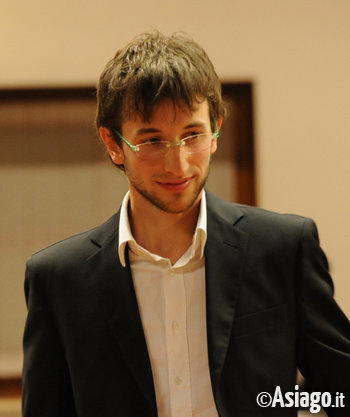Thursday 28/12/2017 at 21:00
Concerts

Music by Haydn, Liszt, Prokofiev, Schoenberg
The traditional Christmas concert proposed by the Association Artemusica Culture, will have as protagonist the pianist Francesco Pulga, which will present pieces by Haydn, Liszt, Prokofiev, Schoenberg. Fans will be invited to a journey through the famous pages of music for solo piano, taking sounds and musical styles that span two centuries of history.
The concert will be held in the Council Chamber in Canove, Thursday 28 January at 21.00, will be followed by light refreshments and admission, as always, is free.
FRANCIS PULGA he graduated with honors at the Conservatory Arrigo Pedrollo "in Vicenza, in February 2009, under the guidance of Maestro Riccardo Zadra.
In 2013 graduated with distinction at the Royal Conservatory of Brussels under the guidance of Maestro Boyan Vodenitcharov, completing his Masters in piano.
By 2015 is attending a pedagogic Master instrumental and with Maestro Jacques Ammon at the Hochschule für Musik und Theater in Leipzig.
Over the years he refined his preparation graduate attending numerous courses and seminars, among which we highlight those held by master Bruno Canino, Aldo Ciccolini, Joaquin Achucarro, Eulalia Solè and Benedetto Lupo.
He has given numerous recitals in Italy, Belgium and Germany, both as a soloist and in Chamber music, having alive appreciation from critics and the public.
From 2012 is the artistic director of the Association Artemusica Culture of Roana.
From 2014 holds with a colleague, Roana, a piano summer Campus, where the idea of teaching is expanded to include classes in Chamber music, theatre, body awareness, improvisation and composition in order to develop creativity and explore aspects of the life of every young musician, often overlooked in traditional music schools.
From January 2017 is Professor of piano at the Music School "Clara Schumann" in Leipzig, and from August 2017 at school "Neue Musik Leipzig".
From October 2017 artistic Assistant at the Hochschule für Musik und Theater in Leipzig.
NOTES ABOUT THE PROGRAM:
Haydn's Variations in f minor belong to the last period of the composer's piano production: composed in Vienna in 1793, reveal the usual highest musical quality. Are characterized by two themes with a strong and very elegant expressiveness: the first in f minor, pensive and gentle at the same time, with its Cadence. the second in f major full of Rococo ornaments. Both themes are varied twice, obeying such an elegant game of alternating between minor and major. The ending offers a synthesis of melodic elements, with a dramatic grain and a force of mold pre-Beethoven.
The final version of 12 studies of transcendental execution that Liszt completed in 1851, is the result of a long work born at least twenty-five years before, started by a Liszt just sixteen. The Studio # 11, harmonies of evening (Andantino) is one of the most poetic passages of the necklace. Lives intense and mysterious atmosphere, with a meditative introduction on color, loads, tonally agreements resonances luminescent elegant arpeggios, moving from an intimate feeling to the triumphant conclusion, which seems irresistible. But it did not happen, because Liszt has already prepared his final: suddenly fades with a charming perpetual murmur on bass, which continues even when you go back to the first theme is more intimate, inanellante its fickle coils with wonderful sweetness; up to commute in harmonious singing of a harp.
In the inexhaustible will to experimentation with Schönberg, the six little pieces op. 19, 1911 's, are a peculiar landing. In this case Schönberg door at the far end a tendency to miniaturize the shape; the six small pieces are really of the aphorisms, the longest of which, the first, does not reach the minute and a half in duration, while the shortest, the fourth, reaches 30 seconds, following a logic really visionary. The first takes place in a whispered pianissimo; the second is based on an incantatory repetition; the third on pronounced contrasts; the fourth and fifth evolve from cantabile situations to other regions. The last is perhaps a tribute to the memory of Gustav Mahler, who died a few weeks earlier, and tends to the dematerialization of sound, silence.
The Piano Sonata No. 4 in c minor by Sergei Prokofiev, was first performed in St. Petersburg in 1918, where the composer spent the years of war and revolution.
The inexhaustible vein of the composer had already produced in those years an amount of extremely personal works that denote maturity and artistic taste.
The Sonata # 4 is divided into three movements: the first has a unique character, the result of a curious combination of two radically different traits. On the one hand, some characteristics make it neo-Baroque, in the vein of stylization of Baroque dance of Prokofiev.
On the other hand, the melodic and harmonic language of the movement, as well as its evocative use of registers of the piano, connect the first movement to the Russian musical fairy tale tradition, especially with their dark and spooky variety.
The second movement is built on a dramatic conflict between the first and second theme darker and chromatic diatonic and lyrical theme, using only the white keys of the piano.
The third movement is a brilliant ironic imitation of the classical style, but is much thicker and bold, full of leaps and dissonance, in the character of this composer. The form of this movement is a sonata-Rondo, very popular with composers of the classical era.
All rights reserved.